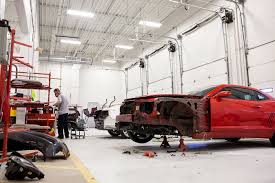The auto body repair industry plays a crucial role in maintaining vehicle functionality, but its operations can also have a significant environmental impact. This impact arises from various factors, including:
- Waste generation: Repair processes produce a substantial amount of waste, encompassing scrap metal, plastic components, packaging materials, and spent solvents. Improper disposal of this waste can lead to environmental contamination and landfill overburden.
- Chemical usage: Auto body repairs often necessitate the use of hazardous chemicals such as paints, thinners, and degreasers. These chemicals pose potential risks to human health and contribute to air and water pollution if not handled and disposed of responsibly.
- Energy consumption: The repair process can be energy-intensive, requiring lighting, heating, and powering equipment. This energy consumption contributes to greenhouse gas emissions and exacerbates climate change.
To mitigate these negative environmental consequences, the industry needs to embrace sustainable practices. Here are some key areas for improvement:
1. Utilizing Eco-Friendly Materials:
- Replacing conventional paints and solvents with water-based or low-VOC alternatives can significantly reduce harmful emissions, thereby improving air quality.
- Incorporating recycled materials into repairs whenever possible minimizes waste generation and promotes resource conservation.
2. Implementing Effective Waste Management:
- Establishing robust waste segregation and recycling programs diverts waste from landfills and fosters resource recovery.
- Collaborating with licensed waste disposal companies ensures the safe and responsible handling of hazardous materials.
3. Fostering Education and Awareness:
- Providing technicians with comprehensive training on the latest eco-friendly repair techniques and materials empowers them to make informed choices that minimize environmental impact.
- Educating customers about the environmental benefits of sustainable repairs encourages them to support businesses that prioritize responsible practices.
4. Embracing Energy-Efficient Technologies:
- Investing in energy-efficient lighting, equipment, and ventilation systems reduces overall energy consumption and lowers the industry's carbon footprint.
- Implementing smart energy management systems allows for real-time monitoring and control of energy use, optimizing resource utilization.
5. Responsible Disposal of Hazardous Waste:
- Adhering to strict regulations and guidelines for handling and disposing of hazardous waste safeguards the environment and minimizes human health risks.
- Utilizing specialized containers and collaborating with approved waste management companies guarantees proper disposal practices.
By adopting these sustainable practices, the auto body repair Las Vegas industry can significantly reduce its environmental footprint and contribute to a healthier planet. Implementing these changes requires a collective effort from businesses, technicians, and consumers, paving the way for a more sustainable future for the industry.
Source - https://www.shaperoflight.com/the-environmental-impact-of-auto-body-repair-sustainable-practices-within-the-industry/


No comments yet